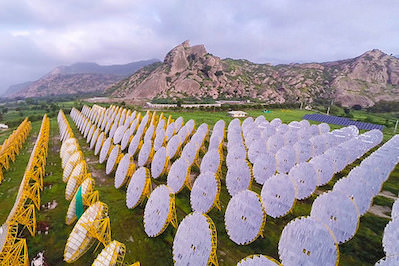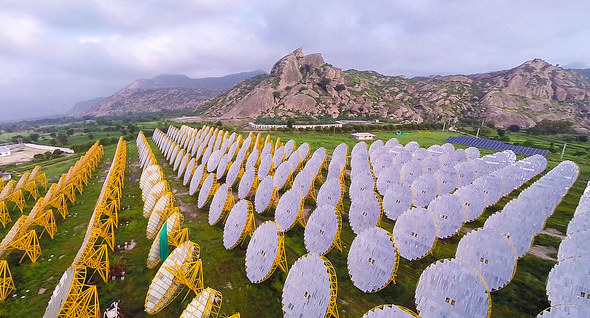India’s Solar Power Is Set to Outshine Coal
By 2020, solar will be a cheaper source of energy in India than imported coal. But converting the subcontinent to renewable energy is an enormous task.
By Henner Weithoener / Climate News Network

The vast India One Solar Thermal Power Plant in Rajasthan may be a sign of the future. (Brahma Kumaris via Flickr)
BERLIN — India wants to provide its entire population with electricity and lift millions out of poverty, but in order to prevent the world overheating it also needs to switch away from fossil fuels.
Although India is blessed with ample sunshine and wind, its main source of energy is coal, followed by oil and gas. Together, they provide around 90% of the total energy demand of the subcontinent — India, Pakistan and Bangladesh — with coal enjoying the highest share, at more than 70%.
The 2016 BP Energy Outlook report assumes that India will depend increasingly on imports for its energy. Domestic production can be increased, but the increase will be overtaken by growing demand. BP says that by 2035 gas imports to India will rise by 573%, oil imports by 169% and coal by 85%.
Renewable thinking
But that assumes that renewables will not take off in India. Others think differently. Bloomberg New Energy Finance reckons that by as early as 2020 large photovoltaic ground-mounted systems will be more economical in India than plants powered by imported coal.
Its conclusion is based on what is called the levelized cost of energy (LCOE) — a way of comparing different methods of electricity generation, using the average total cost of building and operating a power plant, divided by its total lifetime energy output.
“Especially for the 400 million Indians who have no access to electricity, solar power would mean access to
clean and affordable energy”
Bloomberg says the LCOE for photovoltaic systems is about US$0.10 per solar kilowatt hour, compared with a current levelized cost for coal in Asia of about US$0.07.
Even if coal prices remain steady, which it thinks is unlikely, it believes that the continuing fall in PV prices means that solar energy will be more economic than coal by 2020. Only 10 years ago, solar generation was more than three times the price of coal.
One of the pioneering solar manufacturers, Tata Power Solar, estimates that the potential for solar in India lies at about 130 gigawatts by 2025 (one GW is enough to power between 750,000 and a million typical US homes).
“This would generate more than 675,000 jobs in the Indian solar industry,” says Tata Power Solar’s former CEO, Ajay Goel, now president of solar and chief of new businesses at New Delhi-based ReNew Power. “Especially for the 400 million Indians who have no access to electricity, solar power would mean access to clean and affordable energy.”
Solar benefits
After years of standstill on the subcontinent, India seems to be discovering the benefits of solar energy. So the government has recently updated its National Solar Mission target: now it wants to achieve 175GW of renewable power, which includes 100GW of solar power by 2022.
To meet these goals, India will need to increase the pace of its renewable energy capacity addition sevenfold, from an average 3GW per year to at least 20GW per year. Since 2007, the country has averaged only 15GW of new power capacity each year from all technologies.
Bloomberg believes that these targets are difficult to achieve in the given timeframe and will require a serious overhaul of the power infrastructure, as well as new incentives to drive investment.
The International Energy Authority (IEA) agrees. In a special report on India, the agency says that due to population growth the country will need to provide an extra 600 million people with electricity by 2040.
Uncertainty over the pace at which new large dams or nuclear plants can be built means there is a strong reliance on solar and wind power. The IEA says India has high potential and equally high ambition in these areas to deliver on the pledge to build up a 40% share of non-fossil-fuel capacity in the power sector by 2030.
It believes that 340GW of new wind and solar projects, as well as manufacturing and installation capabilities, can be created by 2040 with strong policy support and declining costs.
According to this scenario, the IEA says, the share of coal in the power generation mix falls from 75% to less than 60%, but coal-fired power still meets half of the increase in power generation.
But both the IEA and Bloomberg warn that inadequate transmission infrastructure, open access issues, the poor financial health of distribution companies and a difficult law-making process within the power sector will be the major issues blocking a flow of investment and the proper growth of renewable energy.
So it remains to be seen whether India will put its ambitious plans into practice. The solar potential is obviously there, and at a competitive price. Now people have to start harvesting energy from the sun.
Henner Weithoener, Climate News Network’s Berlin correspondent, is a freelance journalist specialising in renewable energy.
Your support matters…Independent journalism is under threat and overshadowed by heavily funded mainstream media.
You can help level the playing field. Become a member.
Your tax-deductible contribution keeps us digging beneath the headlines to give you thought-provoking, investigative reporting and analysis that unearths what's really happening- without compromise.
Give today to support our courageous, independent journalists.






You need to be a supporter to comment.
There are currently no responses to this article.
Be the first to respond.